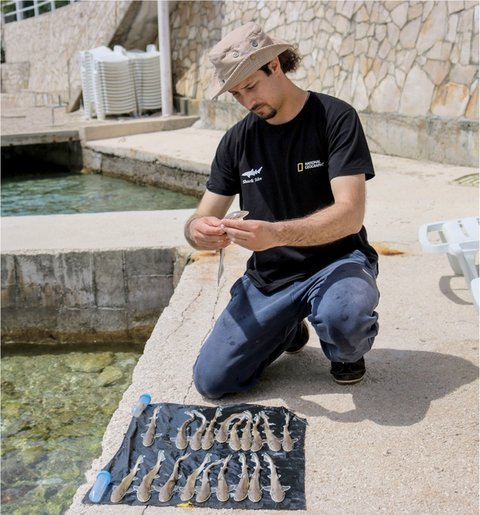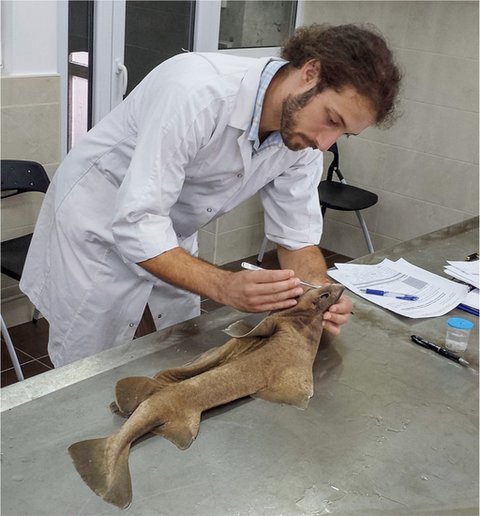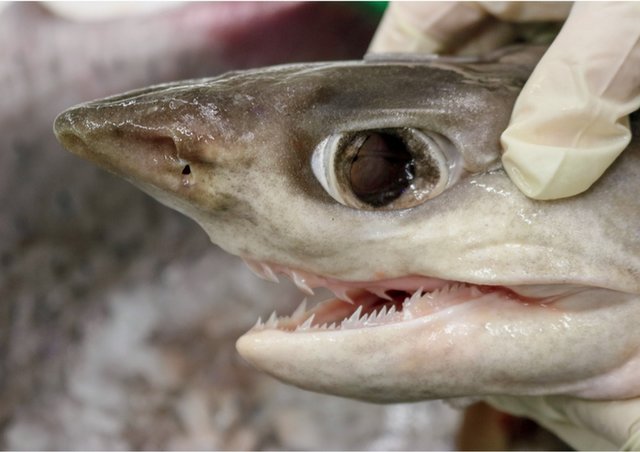SharkSightings
Indeeperwater,Gajićhasencounteredbizarre-lookingroughsharksandlanternsharks.Gajićdoesn’tneedhispowerfulcameralighttoseelanternsharks.Theyglow!Theyarelittlefish,nobiggerthan50centimeters(about20inches)long.Thelightcomesfrommanysmallorganscalledphotophores,whichdottheirbelliesand sides.
Gajić’sinteractionswithraysandskatesarealittlelessproblematicthanwithsharks.He’sabletogetclosertorays,inparticular.Heinteractswithcommonstingrays,eaglerays,andleopardwhipraysashestudies them.
ForGajić,itisadreamcometruetobeamongtheseanimals.Hegrewupinwar‑tornYugoslavia.Hisfamilymovedmanytimeswhenhewasyoung,alwayslookingforasaferandmorestableplacetobe.Heneverlivedanywhereneartheocean.Yet,hewasfascinatedbytheseaandwhatlivedinit,especiallysharks.HewasinspiredbycopiesofNationalGeographicmagazine.Hevowedonedaytovisitsomeofthemagnificentplaceshesawinthemagazineandtoonedayswimwith sharks.

researchingunbornsmoothhound sharks

Gajićexaminesadeep-waterroughsharkinthe lab.
DangerousWaters
Asmuchashelovessharks,GajićknowsthattheyareintroubleintheAdriatic.Pollutioniscausingillnessesinmanymarineanimals.Plastics,pesticides,heavymetals(likelead),andwastepoisonthesea.AndintheAdriatic,warwaste—ammunition,grenades,bombs—alsocontaminatesthewater.ThecoastlinealongNeumisapopularvacationspot.Yet,muchofthetown’ssewageflowsintothesea—someofitisunfilteredwaste.Combined,thesefactorsmakeconditionsforsealife hazardous.
Outwardly,amarineanimalmightseemhealthy.Toknowforcertain,Gajićmusttakeoffhisdivesuitandputonhiswhitelabcoat.Inthelab,heexaminessharkorgansandtissuethroughapowerfulmicroscope.Onlythencanheseewhat’sreally happening.
UndertheMicroscope
Gajićrarelycollectssamplesfromlivesharks.Ifheneedsatissuesample,itistakenfromanalready-deadshark.Thesecomeintheformofbycatch—whenasharkisaccidentallycaughtinafisher’snetandkilled.ManyofthelocalfishersknowthatGajićisstudyingsharksandtheirhealth.Whenasharkiscaughtbymistake,theycontacthim immediately.
Inthelab,eachspecimenisgivenafullx‑rayandaCATscan.Tissuesamplesaretaken.Fromthesesamples,Gajićcanlearnalot.Inoneshark,hefoundanusualamountoffatintheshark’sliver.Itisnormalforthattypeofsharktohaveupto50percentoffatwithintheliver.Thissharkhadfarmorethanthat.Inanothershark,hefoundthediseasehepatitis.That’saninflammationoftheliver.Itmightbecausedbyhighconcentrationsofheavymetalsinthewater.Inothersharks,hefounddiseaseinbothkidneyandbraintissue.Atoneparticularsite,around90 percentofthetissuessampledshowedsomeevidenceof disease.

ThissevengillsharkwasbycatchoffthecoastofMaltaintheMediterranean Sea.